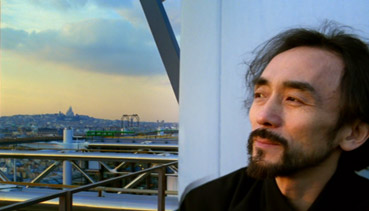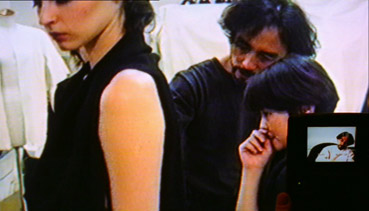|
In
1989, German director Wim Wenders was commissioned by the Centre Pompidou
in France to make a film about the fashion industry, a prospect
he did not initially relish but nonetheless accepted. His
decision to focus on Japanese designer Yohji Yamamoto grew
from the discovery that the two most indefinably perfect items
of clothing he owned were both designed by this man. The
process of making the film prompted him to ponder the nature
of identity and the possible relationship between filmmaking
and fashion design.
As
an investigation of the fashion world, Notebook
on Cities and Clothes reveals more about the filmmaker
than it does about his subject, who is personalised through a series of
interviews but abstracted through the director's experimentation
with his own chosen medium of artistic expression. Armed
with both a film camera and the then new tool of the video-8
palmcorder, Wenders discovers a kind of liberation in the
freedom offered by the camcorder and the intimacy it allows, an early step
on a voyage of digital discovery that many filmmakers would
subsequently take. The rich beauty of the 35mm film images
contrast starkly with the unflattering, high contrast fuzziness
of those shot on the 8mm palmcorder, and Wenders is clearly
fascinated by the juxtaposition of the two, placing one
inside the other in the manner of a pre-digital picture-in-picture.
Intriguing in itself, this inevitably focuses our attention
more on the technique than the content, but does give rise
to some forward-looking questions about the nature of originality
in a soon-to-be-digital age.

Occasionally,
I did find myself connecting with Yamamoto's thinking, as
with his interest in old photographs and more practical fashions,
and I personally share his preference for the asymmetrical
over the symmetrical. But the designer's clearly spoken
but sometimes inexpressive English joins forces with the
distancing effect of the technical handling to create a
barrier to total engagement. This is in contrast to Wenders'
own thoughts, which are clearly communicated through his
softly spoken and articulate voice-over. As a result, we
learn more about Wenders the filmmaker than we do about
Yamamoto the fashion designer, who is at his most communicative
when allowed the full 35mm frame and to speak in his native
language, nicely summing up his sense of temporal conflict
by telling us that "I live in the past and dwell on
the present."
Appropriate to the title, the film is a cinematic notebook
of off-the-cuff observations, partially explored ideas, and
structural and visual experimentation, one that does not quite
feel formed into a completed whole. My failure to completely
engage with Yamamoto is best summed up by a conversation
he has with Wenders in a Parisian pool hall, where I found
myself too easily distracted by a background figure, whose
agitation looked at one point as if it was going to explode
into violence.
As
a whole, Notebook on Cities and Clothes
takes an interesting and offbeat approach to its subject
and includes involving and even insightful moments, but
left this particular viewer little wiser about – or sympathetic
towards – what he still regards, rightly or wrongly, as the
most superficial and fleeting of all creative industries.
Anamorphic
1.78:1, the transfer is up to the standard of the other
films in this box set. It obviously has to cope with
the low band fuzziness of pre-digital 8mm video, although,
as with Lightning
Over Water, this does deliberately and effectively
emphasise the stark contrast between the video and 35mm
imagery, and the 35mm looks very nice.

Dolby
mono 2.0 and surround 5.1 audio options are offered, and
to be honest I preferred the Dolby 2.0, which spreads the
track across the front speakers rather than confining it
to the centre, and has a little more punch as a result.
Another
disc in Anchor Bay's Wim
Wenders Collection that loses out to the US
release, which not only has a director's commentary, but
also deleted scenes and a featurette entitled Twelve
Years Later. Here we get nothing at all.
One
of the few films in Anchor Bay's Wim Wenders Collection
that failed to engage me on a meaningful level, despite
some genuinely interesting asides. My inbuilt disinterest in the
fashion industry in general clearly doesn't help here, but
I was perfectly willing for Wenders to convince me that
there was more substance to it than I've been prepared to
credit it with, but without that commentary it just didn't happen. The autobiographical
elements, however, are always intriguing.
|